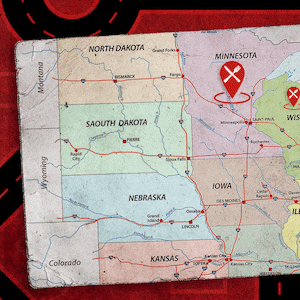Road trips with my family were always adventurous while I was growing up. They served as miniature portals to other worlds where I could gather stories of cultures and livelihoods outside my own. I could experience a quick sampling of a series of alternative realities as an observer in a lengthy car ride.
On our regular trips to the Smoky Mountains, Florida beaches, Disney World, or Nickelodeon Studios, my brother and I lived the best lives that kids could from the backseat. We brought toys, played games, and drank Kool-Aid Bursts or Mondo Squeezers that were packed in the cooler with the rest of the food. Our innocence was centered around each pasture of cows we’d come across or typical, petty sibling fights that ensued because one of us always invaded the other’s personal space.
Despite being born two decades after national protests against Jim Crow laws during the Civil Rights movement, our innocence while traveling dwindled. As the years went on, our trips changed. We became more aware of the small towns we’d pass through, where our parents would not stop to let us grab food or use the restroom—even towns just 30 minutes away from where we lived. My brother—five years older than me—started driving first, and the family always took an anxious pause whenever he was pulled over by a cop or prepared to drive off to college in Tennessee.
ADVERTISEMENT
Driving the Green Book: A Road Trip Through the Living History of Black Resistance by Alvin Hall details the origin of The Negro Motorist Green Book and provides an intricate timeline of racial segregation in America. In the midst of being separate, and certainly not treated as equals, Black Americans had to find a way when there was no way; they found solutions to a system not built in their favor.
In an interview with The Daily Beast, Hall said The Green Book was more than just a 2018 Oscar-winning film that, frankly, didn’t do The Negro Motorist Green Book any justice—outside of highlighting its name. (In fact, Hall, who went to the Academy Award screening of the movie, told The Daily Beast that the title of the film was an after-thought. It didn’t come together until after the film was in post-production.)
The Negro Motorist Green Book was established in 1936 by Victor Hugo Green, a mail carrier in the New York City metropolitan area. He catalogued businesses that were safe for Black Americans to patronize during a time when Jim Crow and segregation thrived. Black drivers did not know where they could safely purchase gas for their vehicles, Black families did not know in which restaurants they were allowed, and Black entertainers could not always find a hotel after performing for white audiences—even in a place as seemingly diverse and progressive as New York City.
The Negro Motorist Green Book grew in popularity, spreading outside of New York City to other areas of the country. Contributors sent submissions to Green and his Harlem-based publishing crew, expanding an underground system for Black travelers to venture into a new form of liberation. The catalog was published yearly—except during World War II—until 1967, when it ceased production.
Cleverly, “the language in the publication [was] filled with gentle euphemisms that would not offend white people,” Hall writes in Driving the Green Book.
Hall, a Black man born in the 1950s Florida Panhandle during what he calls “American apartheid,” thinks The Negro Motorist Green Book’s life ended prematurely.
“Victor Hugo Green always imagined that it would go away, that there would not be a time for it, but I think he was optimistic,” Hall told The Daily Beast, explaining that remnants of Jim Crow were still alive even after the publication ended. “I think that today, it would have morphed much more into a guide for shopping in Black businesses, supporting Black communities. I think it would have evolved into that, but the underlying purpose of it would have been more subtly about these little places where you can be safe.”
The way my mom tells it, my parents integrated my childhood neighborhood in a southeastern Kentucky town in the mid-1980s. She and my father were the first Black family to buy a house in the area and had to have white professionals vouch for them to verify that they were “good people.” There are still neighborhoods in the heavy coal country of southeastern Kentucky, as I understand it, where Black people just don’t go. (This seems likely, considering the many Make America Great Again and Confederate flags I would see while driving through Kentucky hollers on the way to church with my dad.)
After my parents split and I moved to Cincinnati with my mom, it was a completely different environment with more diversity and a rich Black American history. But it was thanks to Hall’s book that I was able to learn about the importance of the Manse Hotel in my own hometown. I also found out why areas were so abruptly distorted by interstate highways and how Americanized “Berlin Walls” designated sundown neighborhoods and suburbs.
Driving the Green Book isn’t just about travel; it maps how racial segregation was—and is—incorporated into multiple facets of life. The influx of Black people into northern and western industrial cities in the postbellum period during the Great Migration led to white residents rioting and destroying Black businesses, something Hall did not hesitate to call a form of domestic terrorism. He claims that “between 1877 and 1950, more than [4,000] Black men, women, and children suffered ‘racial terror lynchings’ in [12] southern states—more than the number of Americans who have been killed by Islamist terrorists, including on 9/11.”
Hall describes in the book how redlining made home ownership harder for Black people and discriminatory realtor habits prevented Black people from moving into white areas, which then affected schooling, access to health care, and spurred food deserts—all things that continue to plague predominantly Black communities.
Older residents in Detroit, Columbus, Cincinnati, Louisville, Memphis, and New Orleans gave their personal accounts to Hall and his travel companions as they took a Jim Crow-inspired “driving while Black” research trip from the North to the South.
The Negro Motorist Green Book provided a support system for Black people to help one another when segregation limited their resources.
In a similar fashion, Driving the Green Book is a clever and necessary read that not only makes sense of history but makes it relevant in the present tense. Hall emphasizes the historical importance of keeping the legacy of the pro-Black catalog alive, something that he believes is especially relevant during a time when ultra conservatives practice revisionist history and place limitations on what history is taught in schools.
He claimed that conservatives purposefully fight against the truth because they don’t want to believe “how difficult it was for African Americans.”
“When the truth began to come out,” he explained to The Daily Beast, “they saw that they were perhaps passively culpable, their parents were actively culpable… They want to always diminish the truth.”
“They don’t think that the truth is going to set you free.”







